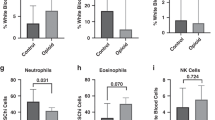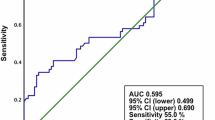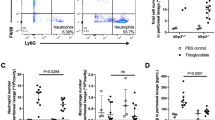Abstract
Neutrophil apoptosis is impaired in neonates, and this contributes to prolonged inflammation and tissue injury in infants after infection or trauma. In the present studies, we investigated whether labor generates mediators that further suppress apoptosis. We found that neutrophil apoptosis was reduced in neonates exposed to labor, when compared with infants delivered by cesarean section before labor. This was not due to alterations in caspase-3 or inhibitor of apoptosis protein-2 (IAP-2). In contrast, labor primed neutrophils to express tumor necrosis factor α (TNF-α), suggesting that proinflammatory mediators contribute to reduced apoptosis after labor. Eicosanoids generated via cyclooxygenase-2 (Cox-2) and lipoxygenase (Lox) also regulate neutrophil apoptosis. 15-Lox, which generates proapoptotic lipoxins, but not Cox-2, was greater in neutrophils before labor, relative to cells exposed to labor. Anti-inflammatory eicosanoids exert their effects in part via peroxisome proliferator–activated receptor γ (PPAR-γ). Expression of gelatinase-associated lipocalin and catalase, two markers of PPAR-γ activity, were increased in neonatal neutrophils before labor, relative to cells exposed to labor. These findings suggest that the anti-inflammatory environment is maintained before labor, in part, by eicosanoids. Although increased neutrophil longevity after labor is important for host defense in the immediate newborn period, it may contribute to inflammatory or oxidative injury in susceptible infants.
Similar content being viewed by others
Log in or create a free account to read this content
Gain free access to this article, as well as selected content from this journal and more on nature.com
or
Abbreviations
- Cox-2:
-
cyclooxygenase-2
- DCF-DA:
-
5- (and -6)-chloromethyl-2′,7′-dichlorodihydrofluorescein diacetate acetyl ester
- IAP-2:
-
inhibitor of apoptosis protein-2
- Lox:
-
lipoxygenase
- N-Gal:
-
neutrophil gelatinase-associated lipocalin
- PMA:
-
phorbol 12-myristate 13-acetate
- PPAR-γ:
-
peroxisome proliferator–activated receptor γ
- ROIs:
-
reactive oxygen intermediates
- SOD:
-
superoxide dismutase
References
Oei J, Lui K, Wang H, Henry R 2003 Decreased neutrophil apoptosis in tracheal fluids of preterm infants at risk of chronic lung disease. Arch Dis Child Fetal Neonatal Ed 88: F245–F249
Hanna N, Vasquez P, Pham P, Heck DE, Laskin JD, Laskin DL, Weinberger B 2005 Mechanisms underlying reduced apoptosis in neonatal neutrophils. Pediatr Res 57: 56–62
Molloy EJ, O'Neill AJ, Grantham JJ, Sheridan-Pereira M, Fitzpatrick JM, Webb DW, Watson RW 2004 Labor promotes neonatal neutrophil survival and lipopolysaccharide responsiveness. Pediatr Res 56: 99–103
Akgul C, Moulding DA, Edwards SW 2001 Molecular control of neutrophil apoptosis. FEBS Lett 487: 318–322
Walmsley SR, Cowburn AS, Sobolewski A, Murray J, Farahi N, Sabroe I, Chilvers ER 2004 Characterization of the survival effect of tumour necrosis factor-alpha in human neutrophils. Biochem Soc Trans 32: 456–460
Gessler P, Dahinden C 2003 Increased respiratory burst and increased expression of complement receptor-3 (CD11b/CD18) and of IL-8 receptor-A in neutrophil granulocytes from newborns after vaginal delivery. Biol Neonate 83: 107–112
Walmsley SR, Print C, Farahi N, Peyssonnaux C, Johnson RS, Cramer T, Sobolewski A, Condliffe AM, Cowburn AS, Johnson N, Chilvers ER 2005 Hypoxia-induced neutrophil survival is mediated by HIF-1alpha-dependent NF-kappaB activity. J Exp Med 201: 105–115
Molloy EJ, O'Neill AJ, Doyle BT, Grantham JJ, Taylor CT, Sheridan-Pereira M, Fitzpatrick JM, Webb DW, Watson RW 2006 Effects of heat shock and hypoxia on neonatal neutrophil lipopolysaccharide responses: altered apoptosis, Toll-like receptor-4 and CD11b expression compared with adults. Biol Neonate 90: 34–39
Hanna N, Graboski S, Laskin DL, Weinberger B 2004 Effects of ibuprofen and hypoxia on neutrophil apoptosis in neonates. Biol Neonate 86: 235–239
O'Neill AJ, Doyle BT, Molloy E, Watson C, Phelan D, Greenan MC, Fitzpatrick JM, Watson RW 2004 Gene expression profile of inflammatory neutrophils: alterations in the inhibitors of apoptosis proteins during spontaneous and delayed apoptosis. Shock 21: 512–518
McMahon B, Godson C 2004 Lipoxins: endogenous regulators of inflammation. Am J Physiol Renal Physiol 286: F189–F201
Scher JU, Pillinger MH 2005 15d-PGJ2: the anti-inflammatory prostaglandin?. Clin Immunol 114: 100–109
Garcia-Bueno B, Madrigal JL, Lizasoain I, Moro MA, Lorenzo P, Leza JC 2005 Peroxisome proliferator-activated receptor gamma activation decreases neuroinflammation in brain after stress in rats. Biol Psychiatry 57: 885–894
Allgaier B, Shi M, Luo D, Koenig JM 1998 Spontaneous and Fas-mediated apoptosis are diminished in umbilical cord blood neutrophils compared with adult neutrophils. J Leukoc Biol 64: 331–336
Logdberg L, Wester L 2000 Immunocalins: a lipocalin subfamily that modulates immune and inflammatory responses. Biochim Biophys Acta 1482: 284–297
Youssef J, Badr M 2004 Role of peroxisome proliferator-activated receptors in inflammation control. J Biomed Biotechnol 2004: 156–166
Fadeel B, Ahlin A, Henter JI, Orrenius S, Hampton MB 1998 Involvement of caspases in neutrophil apoptosis: regulation by reactive oxygen species. Blood 92: 4808–4818
Hanna N, Bonifacio L, Weinberger B, Reddy P, Murphy S, Romero R, Sharma S 2006 Evidence for interleukin-10-mediated inhibition of cyclo-oxygenase-2 expression and prostaglandin production in preterm human placenta. Am J Reprod Immunol 55: 19–27
O'Neill A, Greenan MC, Doyle B, Fitzpatrick JM, Watson RW 2004 Gene profiling of in vitro and in vivo models of delayed neutrophil apoptosis: a common pathway?. Biochem Soc Trans 32: 470–473
Wang CY, Mayo MW, Korneluk RG, Goeddel DV, Baldwin AS Jr 1998 NF-kappaB antiapoptosis: induction of TRAF1 and TRAF2 and c-IAP1 and c-IAP2 to suppress caspase-8 activation. Science 281: 1680–1683
Leitich H 2005 Controversies in diagnosis of preterm labour. Br J Obstet Gynaecol 112: 61–63
Park JS, Park CW, Lockwood CJ, Norwitz ER 2005 Role of cytokines in preterm labor and birth. Minerva Ginecol 57: 349–366
Speer CP 1999 Inflammatory mechanisms in neonatal chronic lung disease. Eur J Pediatr 158: S18–S22
Rezaie P, Dean A 2002 Periventricular leukomalacia, inflammation and white matter lesions within the developing nervous system. Neuropathology 22: 106–132
Lee TH, Horton CE, Kyan-Aung U, Haskard D, Crea AE, Spur BW 1989 Lipoxin A4 and lipoxin B4 inhibit chemotactic responses of human neutrophils stimulated by leukotriene B4 and N-formyl-L-methionyl-L-leucyl-L-phenylalanine. Clin Sci (Lond) 77: 195–203
Filep JG, Zouki C, Petasis NA, Hachicha M, Serhan CN 2002 Lipoxin A4 and aspirin-triggered 15-epi-lipoxin A4 modulate adhesion molecule expression on human leukocytes in whole blood and inhibit neutrophil-endothelial cell adhesion. Adv Exp Med Biol 507: 223–228
Kantarci A, Van Dyke TE 2003 Lipoxins in chronic inflammation. Crit Rev Oral Biol Med 14: 4–12
Ottonello L, Gonella R, Dapino P, Sacchetti C, Dallegri F 1998 Prostaglandin E2 inhibits apoptosis in human neutrophilic polymorphonuclear leukocytes: role of intracellular cyclic AMP levels. Exp Hematol 26: 895–902
Hanna N, Hanna I, Hleb M, Wagner E, Dougherty J, Balkundi D, Padbury J, Sharma S 2000 Gestational age-dependent expression of IL-10 and its receptor in human placental tissues and isolated cytotrophoblasts. J Immunol 164: 5721–5728
Vermillion ST, Landen CN 2001 Prostaglandin inhibitors as tocolytic agents. Semin Perinatol 25: 256–262
Chinetti G, Fruchart JC, Staels B 2000 Peroxisome proliferator-activated receptors (PPARs): nuclear receptors at the crossroads between lipid metabolism and inflammation. Inflamm Res 49: 497–505
Lappas M, Permezel M, Georgiou HM, Rice GE 2002 Regulation of proinflammatory cytokines in human gestational tissues by peroxisome proliferator-activated receptor-gamma: effect of 15-deoxy-Delta(12,14)-PGJ(2) and troglitazone. J Clin Endocrinol Metab 87: 4667–4672
Victor VM, Rocha M, De la Fuente M 2004 Immune cells: free radicals and antioxidants in sepsis. Int Immunopharmacol 4: 327–347
Bortolussi R, Howlett S, Rajaraman K, Halperin S 1993 Deficient priming activity of newborn cord blood-derived polymorphonuclear neutrophilic granulocytes with lipopolysaccharide and tumor necrosis factor-alpha triggered with formyl-methionyl-leucyl-phenylalanine. Pediatr Res 34: 243–248
Komatsu H, Tsukimori K, Hata K, Satoh S, Nakano H 2001 The characterization of superoxide production of human neonatal neutrophil. Early Hum Dev 65: 11–19
Marodi L, Goda K, Palicz A, Szabo G 2001 Cytokine receptor signalling in neonatal macrophages: defective STAT-1 phosphorylation in response to stimulation with IFN-gamma. Clin Exp Immunol 126: 456–460
Kinnula VL, Soini Y, Kvist-Makela K, Savolainen ER, Koistinen P 2002 Antioxidant defense mechanisms in human neutrophils. Antioxid Redox Signal 4: 27–34
Asikainen TM, White CW 2004 Pulmonary antioxidant defenses in the preterm newborn with respiratory distress and bronchopulmonary dysplasia in evolution: implications for antioxidant therapy. Antioxid Redox Signal 6: 155–167
Girnun GD, Domann FE, Moore SA, Robbins ME 2002 Identification of a functional peroxisome proliferator-activated receptor response element in the rat catalase promoter. Mol Endocrinol 16: 2793–2801
Davis JM, Parad RB, Michele T, Allred E, Price A, Rosenfeld W 2003 Pulmonary outcome at 1 year corrected age in premature infants treated at birth with recombinant human CuZn superoxide dismutase. Pediatrics 111: 469–476
Author information
Authors and Affiliations
Additional information
Supported by National Institutes of Health grants HD042036, ES005022, GM034310, ES004738, HL067708, and CA100994.
Rights and permissions
About this article
Cite this article
Weinberger, B., Vetrano, A., Syed, K. et al. Influence of Labor on Neonatal Neutrophil Apoptosis, and Inflammatory Activity. Pediatr Res 61, 572–577 (2007). https://doi.org/10.1203/pdr.0b013e318045be38
Received:
Accepted:
Issue date:
DOI: https://doi.org/10.1203/pdr.0b013e318045be38



